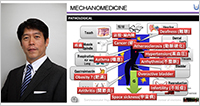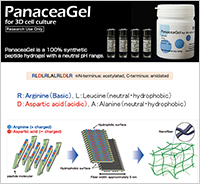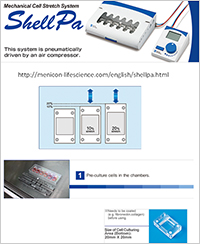ADVISOR, MENICON
Enlarge Image PanaceaGel
Enlarge Image Mechanical Cell Stretch System
Enlarge Image Sperm Sorter
Enlarge Image
MECHANOMEDICINE: Insights into mechanical stress in clinical medicine
Keiji Naruse is renowned for this research on ‘mechanobiology’—a term that he created to describe and visualize his work that integrates the mechanics of human tissue. “My interest in the mechanical aspects of the body began as a medical student,” says Naruse. “I recall asking a lecturer about why cells and tissues expand and contract and being told to ‘find out for yourself’. So that was the beginning of my research on ‘mechanobiology’.”
The sense of touch registered by our skin, sudden increases in the heartrate during exercise, and the vibration of the liquid inside the cochlea are examples of the effects of stimuli on our body. In their research, Naruse and colleagues are addressing issues including how mechanical stress (stretching and shear) affects the cardiovascular system (myocardial regeneration/arrhythmia), reproductive system (sperm separation and fertilized egg culture) and medical materials (hemostatic agents).
Importance of translational research and establishing bio-venture companies
“I firmly believe in commercializing ideas and research findings,” says Naruse. “I am working with partners both in Japan and overseas on translating our research into healthcare products.”
To address infertility, Naruse and his colleagues have focused on the importance of mechanical stress in the oviduct for fertilization—mechano-reproduction—and developed the ‘Improved Human Assisted Reproductive Technology’ (iHART). This protocol consists of a Microfulidic Sperm Sorter (Qualis) and Tilting Embryo Culture System (TECS). “Our mechano-reproduction research is based on integrating microfluidics with materials used for producing soft contact lens,” explains Naruse. “This system was approved by the FDA in June 2014. It is in use at clinics in Japan.”
Qualis Sperm Sorter (In Japanese)
http://menicon-lifescience.com/qualis.html
Another example of an idea taken from the lab to patient care is the ‘panaceaGel’— a neutral self-assembling peptide hydrogel— used as a scaffold in three-dimensional cell culture and as a carrier for drug delivery. Another important application of this material is as a coagulant to rapidly stop bleeding: The Neutral Self-Assembling Peptide Hydrogel SPG-178 as a Topical Hemostatic Agent, PLOS One, July 21, 2014, http://dx.doi.org/10.1371/journal.pone.0102778.
PanaceaGel
http://menicon-lifescience.com/english/panaceagel.html
Information about STREX Inc
http://www.menicon-lifescience.com/english/
Future
“I am continuing to expand our research on mechanobiology and applications of mechanical stress-inducing instruments for the life sciences,” says Naruse. “Projects on the horizon include space medicine in collaboration with Japanese astronauts working in the International Space Station. There are still many unexplored frontiers in cell response to mechanical stimuli.”
Selection of publications
・Stretch and microfluidics
“Laminar flows: Subcellular positioning of small molecules”
Nature 411, 1016 (28 June 2001)
doi:10.1038/35082637
http://www.nature.com/nature/journal/v411/n6841/full/4111016a0.html
・Calcium influx through stretch activated channels
“Ca2+ influx and ATP release mediated by mechanical stretch in human lung fibroblasts”
Biochemical and Biophysical Research Communications , vol.453, 101 - 105, October 2014.
doi: 10.1016/j.bbrc.2014.09.063
http://www.sciencedirect.com/science/article/pii/S0006291X1401688X
・Generation of temporally controlled cardiac-specific TRPV2-deficient mice
“TRPV2 is critical for the maintenance of cardiac structure and function in mice”
Nature Communications 5, Article number: 3932 (2014)
doi:10.1038/ncomms4932
http://www.nature.com/articles/ncomms4932
・Mechano-cardiovascular: Stretch-induced arrhythmia
“Effect of azelnidipine and amlodipine on single cell mechanics in mouse cardiomyocytes”
European Journal of Pharmacology, vo. 715, 142-146, September 2013.
doi: 10.1016/j.ejphar.2013.05.030
http://www.sciencedirect.com/science/article/pii/S0014299913004378
・Stretching of single cardiomyocyte
“Load dependency in force–length relations in isolated single cardiomyocytes”
Progress in Biophysics and Molecular Biology, vol.115, 103-114, August 2014.
doi: 10.1016/j.pbiomolbio.2014.06.005
http://www.sciencedirect.com/science/article/pii/S0079610714000479
Further information
Keiji Naruse, Graduate School of Medicine, Dentistry and Pharmaceutical Sciences
http://soran.cc.okayama-u.ac.jp/view?l=en&u=ffa8175b01c957f574506e4da22f6611




